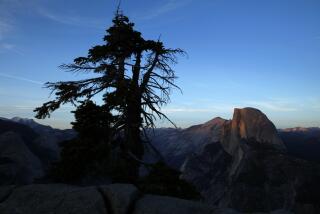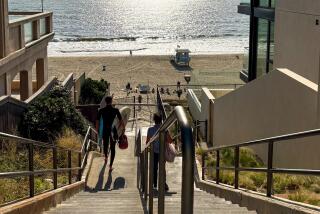A High Climb Leads Up to Hawaii’s Best View
KANEOHE, Hawaii — The Haiku Stairs may be Oahu’s least advertised adventure. Yet it is also one of this island’s most breathtaking outings, both figuratively and literally.
For at the top of the stairs, visitors will discover a spectacular 360-degree view of the entire island.
The best part is that there is no charge to go up the stairs, and the three- to four-hour average round-trip time to see the stairs makes it a quick half-day outing.
There is one catch: This trip is reserved for the hardy of spirit--and of body. Mounting the 3,922 steps up the Koolau Mountain range is a little better than scaling those of the Empire State Building. Twice.
But don’t ask the tour guides how to get there. Even most natives don’t know about the stairs, which rise a staggering 2,800 feet up one side of the Haiku Valley on the windward side of the island.
The stairs comprise hundreds of sections of metal ladder attached with steel spikes to the side of the cliff, or pali . They were built by the Navy during World War II as an access to signaling equipment installed on the mountain’s peak.
The stairs now belong to the U.S. Coast Guard’s Omega Station, a communications and navigation information facility based in Haiku Valley since 1975. Coast Guard personnel use the stairs only once or twice a year to service a wire antenna that spans the valley, according to the station’s commanding officer, Norman Cox.
Stairs Closed in 1987
In fact, Cox said the antenna is due for major repairs and maintenance in 1987 and as a result, the stairs will be closed to the public for four months beginning March 15.
The structure is also sometimes called the “Stairway to Heaven,” which is easy to understand looking up from the bottom and seeing the steps disappear into the clouds.
The stairs have only been open to the public since 1982, at which time reservations were required of all who wanted to go up.
Cox said those regulations were liberalized about two years ago so that now reservations are necessary only on weekends and holidays. The phone number at the station for reservations or other information is (808) 235-4981.
The number of visitors is limited to 50 a day--to prevent cross traffic on the narrow stairway. But even that small number is rarely reached. Cox said that tourist traffic averages 700 a month, less than the average single-day attendance at more traditional tourist stops like the Polynesian Cultural Center.
The incline averages about 60 degrees and in numerous places is virtually vertical. There are handrails, but the Coast Guard warns quite accurately that the ladder is not maintained and sections cannot support much weight.
Waive Liability
Therefore, before going up, visitors are required to sign in at the Coast Guard station and fill out an imposing-sounding waiver releasing the U.S. government of any liability for accidents incurred on the stairs.
But don’t let that scare you off. Cox says that the safety record of the ladder is spotless. “There have been no serious accidents to my knowledge. Sure, we’ve gotten some scraped knees, but--knock on wood--no one’s ever come screaming that they broke an arm or a leg.”
Cox does caution interested climbers to leave the kids at home. “Generally we don’t want children under 12 years old going up. They are not of sufficient height to get up some portions of the ladder or of the mental attitude to make a climb like that.”
For those who decide that the trek is too arduous, the drive needn’t be a total loss. About half a mile below the gate marking the entrance to the Omega station are the Haiku Gardens and restaurant, a serenely beautiful spot from which to view the mountain peak from the bottom up.
And once on the east side of Oahu, you are only a short drive from any number of usually uncrowded beaches as well as tourist spots such as the Byodoin Temple in the Valley of the Temples.
Wait for Clear Day
For those who decide to tackle the Haiku Stairs, there are several factors to keep in mind. First, wait for a clear day, as the peak is frequently shrouded by clouds. That doesn’t make it particularly dangerous, but clouds can obscure the panoramic view.
“It’s quite a unique feeling if you get up there on a clear day,” Cox admitted.
Second, allow plenty of time for rest stops and picture taking. Also, carry water and perhaps a snack of crackers and fruit. And even if it is quite warm and sunny at the trail head that leads to the stairs, take a light jacket along, as winds at the top of the peak can get very chilly.
And don’t start too late in the day. Said Cox, “Generally we will not let people go up after 2 p.m., because they don’t come down until after dark. In some sections the handrails are behind you, so to me that’s the most dangerous part.”
Not everyone takes 90 minutes or more to scale the pali. “We’ve had some Marine units make it up in 50 minutes,” Cox said. “There is no official record, although we had one guy here who used it for conditioning and went up two or three times a week. He could do it in 45 to 47 minutes.”
Third, wear good athletic shoes or hiking boots. And bring heavy cotton or leather gloves--you’ll want them, especially for preventing blisters on the trip down, which can be arduous on the hands. (You can pick up gloves in Waikiki for a couple of bucks at the Woolworth’s store if you forget to pack them.)
You might also consider bringing along a small day pack into which you can put everything you’ll need and still keep your hands free. Take a couple of rolls of film for the various scenic viewpoints you’ll find.
Repelling Insects
If you’re susceptible to bug bites, apply some insect repellent before starting up because the early sections of the climb are heavily forested although quite beautiful.
You won’t find the Haiku Stairs on most maps of Oahu, but you can find the Haiku Valley easily enough. Coming over the Likelike Highway from Waikiki toward Kaneohe, turn north on the Kahekili Highway and continue until you come to Haiku Road.
The entrance to the Coast Guard station is about two miles west, and don’t think you’ve taken a wrong turn when Haiku Road becomes a narrow, dirt country road. From the entrance gate, arrows direct you to the station where you sign in and get a map showing the location of the trail head that leads to the stairs.
Keep in mind, this isn’t for the average tourist--just for those adventurous souls who are in relatively good physical shape. But as one who has made the climb twice, I’d recommend it as a singularly unforgettable Hawaiian experience.
More to Read
Sign up for The Wild
We’ll help you find the best places to hike, bike and run, as well as the perfect silent spots for meditation and yoga.
You may occasionally receive promotional content from the Los Angeles Times.






